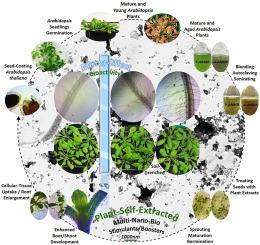Sustainable extraction of personalized plant nano-stimulants from conspecific donor plants to induce mirror biostimulant activity in identical host plants
引用次数: 0
Abstract
Conventional agrochemical plant biostimulants have been used to increase crop yield and stress resistance, and this strategy continues to be integral to today's farming. While effective, the large-scale implantations of these products are not without environmental, ecological, and cost concerns and the associated climate-change challenges. To alleviate this long-standing pressure on agriculture, designing and developing more biocompatible and sustainable plant stimulants are among the primary focuses of agricultural management. Over the recent decades, the field has witnessed significant progress in emerging naturally derived or nature-inspired nano-biostimulants with large-active-surface areas, including bio-compounds, biopolymers, and nanocarbons. However, the extraction/preparation of these products may apply additional costs or require specific equipment. More recently, the field's attention has shifted to the sustainable application of chemical-additive-free biostimulants towards practical applications in nano-agriculture. Herein, we rationally designed and reported the first evidence and elucidation on biostimulant impacts of plant-self-derived nano-extracts from donor Arabidopsis thaliana as a model for inducing mirror biostimulant activities in conspecific host seeds, seedlings, and plants. Moreover, we assessed the effect of donor plants' age on short--, mid-, and long-term biocompatibility, growth, and development/maturation of the recipient plants for up to around 30 days. As a proof-of-concept, we found these autologous bio-extracts could effectively promote seed sprouting, seedling germination, and the development of soil-drenched plants of the same types. Our transmission-electron microscopy characterization of root/shoot pieces shows the presence of multiple phyto-compounds, including microtubules/actin filaments, cell vacuoles, Golgi stacks/endoplasmic reticulum, cell wall polysaccharide-based cellulose fibers, and organic amorphous nanoparticles and clusters of carbon quantum dots in the structure of these extracts. This personalized plant stimulation may induce further growth/defense-related mechanisms, setting new paradigms toward reducing the agrochemical inputs.

从同种供体植物中可持续提取个性化植物纳米刺激物,以诱导相同寄主植物的镜像生物刺激物活性
传统的农业化学植物生物刺激剂已被用于提高作物产量和抗逆性,这一策略仍然是当今农业的组成部分。这些产品的大规模植入虽然有效,但并非没有环境、生态和成本问题以及相关的气候变化挑战。为了减轻这种对农业的长期压力,设计和开发更具生物相容性和可持续的植物兴奋剂是农业管理的主要重点之一。近几十年来,该领域在新兴的天然衍生或受自然启发的具有大活性表面积的纳米生物刺激剂方面取得了重大进展,包括生物化合物、生物聚合物和纳米碳。然而,这些产品的提取/制备可能需要额外的成本或需要特定的设备。最近,该领域的注意力已从无化学添加剂的生物刺激剂的可持续应用转向纳米农业的实际应用。在此,我们合理设计并报道了从供体拟南芥中提取的植物自源纳米提取物作为诱导同种寄主种子、幼苗和植物镜像生物刺激素活性的模型的第一个证据和阐明。此外,我们评估了供体植株年龄对受体植株短期、中期和长期生物相容性、生长和发育/成熟的影响,最长可达30天左右。作为概念验证,我们发现这些自体生物提取物可以有效地促进种子发芽、幼苗发芽和同类型土壤浸湿植物的发育。我们的根/芽片的透射电镜表征显示了多种植物化合物的存在,包括微管/肌动蛋白细丝,细胞液泡,高尔基堆/内质网,细胞壁多糖基纤维素纤维,以及这些提取物结构中的有机无定形纳米颗粒和碳量子点簇。这种个性化的植物刺激可能会诱导进一步的生长/防御相关机制,为减少农用化学品投入设定新的范例。
本文章由计算机程序翻译,如有差异,请以英文原文为准。
求助全文
约1分钟内获得全文
求助全文

 求助内容:
求助内容: 应助结果提醒方式:
应助结果提醒方式:


